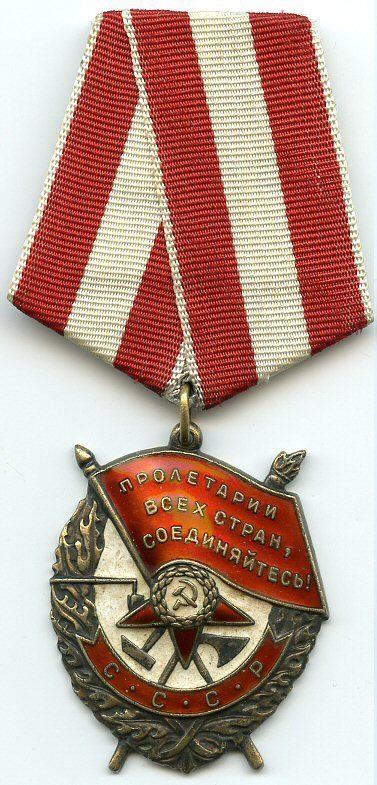Type Single-grade order Status No longer awarded Last awarded 1991 | Established August 1, 1924 | |
 | ||
Awarded for Heroism in combat or long service in the armed forces | ||
The Order of the Red Banner (Russian: Орден Крaсного Знамени) was the first Soviet military decoration. The order was established on 16 September 1918, during the Russian Civil War by decree of the All-Russian Central Executive Committee. It was the highest award of Soviet Russia, subsequently the Soviet Union, until the Order of Lenin was established in 1930. Recipients were recognised for extraordinary heroism, dedication, and courage demonstrated on the battlefield. The order was awarded to individuals as well as to military units, cities, ships, political and social organizations, and state enterprises. In later years it was also awarded on the twentieth and again on the thirtieth anniversary of military service without requiring participation in combat.
Contents
Award history
The Russian Order of the Red Banner was established during the Russian Civil War by decree of the All-Russian Central Executive Committee of September 16, 1918.
The first recipient was Vasily Blyukher on September 28, 1918. The second recipient was Iona Yakir.
During the Civil War there existed similarly named orders and decorations established by the Soviet communist governments of several other constituent and nonconstituent republics. The August 1, 1924 decree of the All-Russian Central Executive Committee established the all-Soviet Order of the Red Banner for deserving personnel of the Red Army.
Other nonmilitary awards also used the phrase "Order of the Red Banner" in their title; for example, the Order of the Red Banner of Labour was presented for acts of great scientific, military (technical or logistic), manufacturing, or agricultural achievement.
From 1918 till the late 1930s there was also a collective variant - the Revolutionary Red Banner of Honor. This was in the form of a military color awarded to distinguished Red Army, Soviet Air Force and Soviet Navy units. It was more older than the order, having been established on August 3, a month and several weeks before.
Award statute
As a military decoration, The Order of the Red Banner recognised heroism in combat or otherwise extraordinary accomplishments of military valour during combat operations. Before the establishment of the Order of Lenin on April 5, 1930, the Order of the Red Banner functioned as the highest (and practically the only) military order of the USSR. During World War II, under various titles (including the Order of the Red Banner of Military Valour and Order of the Red Banner for Maritime Valour), it was presented both to individuals and to units for acts of extreme military heroism. In some ways, the Order of the Red Banner was more prestigious, as it could only be awarded for bravery during combat operations whereas the Order of Lenin was sometimes awarded to non-military personnel and political leaders. Nearly all well-known Soviet commanders became recipients of the Order of the Red Banner.
The order was awarded to individuals as well as whole formations, which then added the prefix "Red Banner" to their official designations. Naval vessels also flew a special ensign.
Long service award
The Order of the Red Banner was also used as a long service award between 1944 and 1958 to mark twenty and thirty years of service in the military, state security, or police. Decree of the Presidium of the Supreme Soviet of the USSR of September 14, 1957 emphasised the devaluation of certain Soviet high military Orders used as long service awards instead of their originally intended criteria. This led to the joint January 25, 1958 decree of the Ministers of Defence, of Internal Affairs and of the Chairman of the Committee on State Security of the USSR establishing the Medal "For Impeccable Service" putting an end to the practice.
Award description
The order consisted of a white-enamelled badge, which had a golden Hammer and Sickle badge surrounded by two golden panicles of wheat on a Red Star, backed by crossed hammer, plough, torch and a red flag bearing the motto Proletarians (Workers) of the World, Unite!. This was surrounded by two golden panicles of wheat; at the bottom were the letters "SSSR" (Russian: СССР). Additional awards of the Order bore a white enamelled shield with a silver sequence number at the bottom of the obverse. A recipient of three Orders of the Red Banner would wear a basic badge of the order followed by his second award bearing a number "2" and his third award bearing a number "3".
The early variants of the Order were screw back badges to allow wear on clothing. Later variants (1943) hung from a standard Soviet pentagonal mount with a ring through the suspension loop. The mount was covered with an overlapping 24mm wide red silk moiré ribbon with 1.5mm wide white edge stripes and a 7mm wide white central stripe.
The Order of the Red Banner was worn on the left side of the chest and when in the presence of other Orders and medals of the USSR, was placed immediately after the Order of the October Revolution. If worn in the presence of Orders or medals of the Russian Federation, the latter have precedence.
Formations
Individual feats
Feats of valour worthy of the award of the Order of the Red Banner were as much against internal as against external enemies of the USSR as detailed below:
